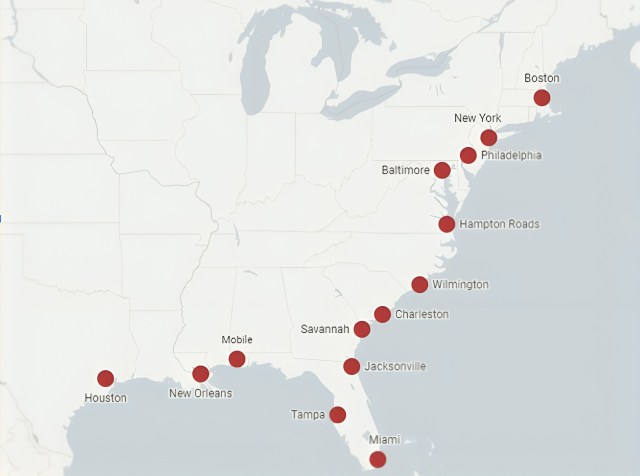Approximately 45,000 dock workers at U.S. ports along the East Coast and Gulf of Mexico went on strike just after midnight on October 1st, 2024, disrupting the flow of goods in and out of the country. It’s the first strike by the International Longshoremen’s Association since 1977 and could significantly impact the global supply, potentially leading to shortages of goods like household essentials and electronics, automotive parts, agricultural goods, and even baby formula.
What’s happening?
The strike will primarily affect goods from Europe, India, and other countries that rely on direct shipping routes across the Atlantic Ocean. East Coast and Gulf Coast ports handle between 43% to 49% of the total containerized goods entering the United States, making them a critical hub for imports. Here’s a look at the ports being impacted by the strike.

Source: OpenStreetMap Contributors
While the effects won’t be as dramatic as what we saw during the COVID lockdowns, we can still expect disruptions in key sectors like retail, automotive, manufacturing, and, to some extent, agriculture, which faces unique challenges due to the perishability of its products.
What’s at stake?
The strike’s economic impact largely depends on how long the work stoppage lasts. The longer the strike goes on, the more severe the disruptions. Goods waiting offshore could be rerouted, delayed, or, in some cases, even canceled. When ships are forced to sit idle or reroute, it adds costs for carriers, who typically pass those costs on to consumers and businesses through surcharges.
For every day of the strike, it takes four to six days to clear the backlog. If the stoppage stretches to a week or longer, it could take weeks — if not months— for supply chains to return to normal.
The contingency plan
To mitigate the damage, some companies have already rerouted their goods to West Coast ports or opted to send freight by air. However, these options aren’t available for every product, and they come with higher costs. Flexibility is crucial, but the strain on the supply chain will be significant, especially given that schedules for cargo ships are set weeks or months in advance.
This situation echoes the challenges we saw during the pandemic, and companies are scrambling to adapt their supply chains. Some are turning to “near-shoring,” moving manufacturing closer to their customers to reduce the dependency on long-haul shipping. But this isn’t a solution that can be implemented overnight. It requires time, resources, and infrastructure, which means many companies remain vulnerable.
Why timing matters
This strike couldn’t have come at a worse time — right at the start of peak consumer demand season. Retailers are ramping up inventories in preparation for the holiday shopping season, and many shippers have increased their volume at the impacted ports to get ahead of the work stoppage. Despite these efforts, not all sectors have been able to avoid delays.
Ripple effects on transportation
As the strike lingers, ripple effects will be felt across the entire transportation system. Increased demand for trucking and rail services will strain capacity and likely lead to further delays. Although these forms of transportation are more nimble than ocean freight, repositioning equipment and adding capacity takes time and comes with additional costs.
In the end, the lack of cargo fluidity will likely result in higher prices for goods. It’s estimated that each day ports remain closed, it costs the U.S. economy $4.5 billion. The longer the strike continues, the greater the likelihood of product shortages, price hikes, and even layoffs in sectors dependent on raw materials.
What can businesses do?
To weather this storm, companies in the supply chain, especially trucking and rail companies, should have active conversations with their partners to understand how the strike could impact their business. Having robust contingency plans in place is essential. It’s not just about keeping operations running; it’s about keeping customers informed and reassured during times of uncertainty.
Final thoughts
The port strike is an urgent reminder of just how fragile the supply chain can be. Whether you’re in retail, manufacturing, or transportation, preparation is key. With the right strategies, businesses can minimize disruptions and continue to serve their customers through these challenging times.
Steve Keppler is Co-Director of Scopelitis Transportation Consulting and a Motive contractor.




